- JAPANESE
- LANGUAGE
X
 THAT IS GOOD
THAT IS GOOD
The next day, we left the inn and visited the Tokamachi City Museum, which was not renovated at the time, to see the various artifacts excavated from the area, including the national treasure, Jomon Vessel with Flame-like Ornamentation. In particular, the Jomon Vessel with Flame-like Ornamentation, designated National Treasure No. 1, had a well-proportioned shape with a slim body, and I thought it was a miracle that it had been unearthed in almost perfect shape after 5,500 years.
After that, we drove to the Sasayama Site where a national treasure was unearthed. We crossed the Iiyama railway line from the city center where the museum is located and drove up a gentle hill, where we saw two restored pit houses on a grassy slope. The surrounding area is a sports park with an athletic field and a baseball field, and as we got out of the car, we could hear the shouts of children playing sports.
I had hoped that visiting the ruins would give me some idea of what to expect, but it is difficult to get a sense of the atmosphere of the Jomon period in this day and age. The lawn was neatly mowed and easy to walk on, but there was no denying that it felt like a modern park. In addition, although some of the Sasayama Site has been preserved after excavation, most of it was lost during the construction of the sports park. The only clue to imagine the Jomon period is the topography.
The Sasayama Site is located on top of a hill, so it probably has a good view. However, it was cloudy that day, and the panorama was not as good as we had expected. It started to rain, so we decided to get back in the car and return to Tsunan. Our destination was the Tsunan Town History Folk Museum, located along the Nakatsu River, a tributary of the Shinano River.
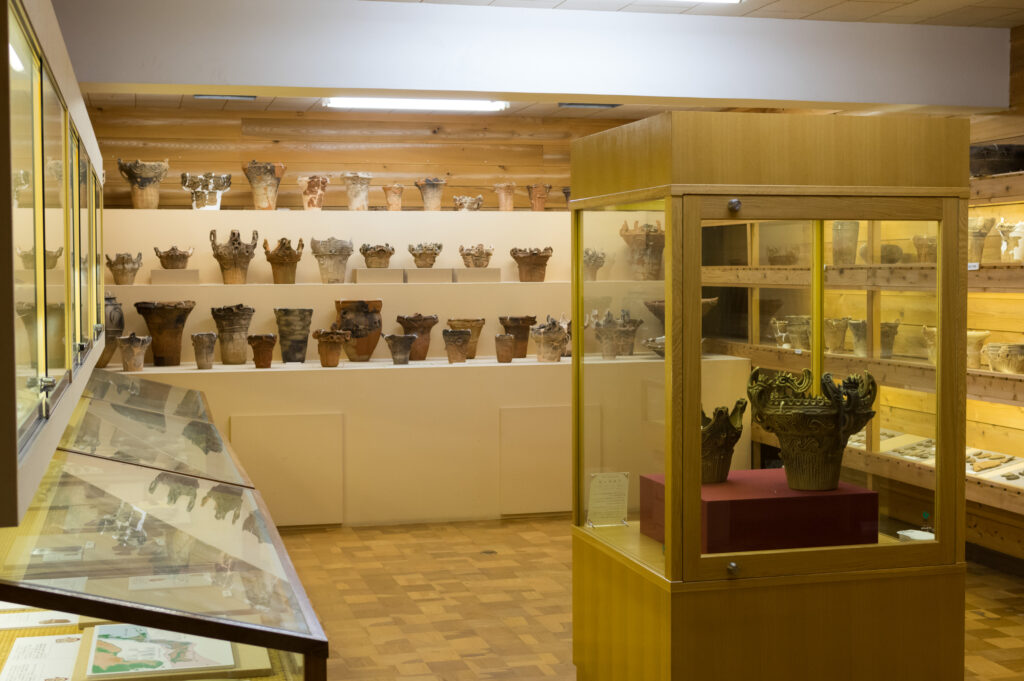
The museum is a storehouse-style building with an old thatched-roof house attached to it, and is divided into two floors: the second floor with an exhibition room of folk tools, and the third floor with an archaeological exhibition room. After checking in at the reception desk and changing into slippers, we entered the building and were greeted with the distinctive smell of an old building.
First, we went up to the third floor to see the flaming earthenware from the Dodaira site, a national important cultural property, sitting in a glass case in the middle of the room. Next to it, the Jomon Crown Pot, which is said to be excavated in pairs with the Jomon Vessel with Flame-like Ornamentation, was lined up with a calm atmosphere. By the way, there was also a pair of Jomon Crown Pot on display as a national treasure at the Tokamachi Museum. It is known that Jomon people practiced rituals, but were these special earthenware vessels used as ritual tools? I don’t know what the truth is, but when I look at them as a pair, they look like a man and a woman, an adult and a child, motion and stillness. I feel as if I am being told by earthenware that there are two sides to everything.
Hirokawa, who was looking into the glass case next to me, said, ” It’s no longer a pot, is it?
Oh yes, I had forgotten that this was a pot. It was Tatsuo Kobayashi, an archaeologist from Nagaoka, who described Jomon earthenware as “letting go of the vessel,” but I had completely forgotten that I was looking at a vessel.
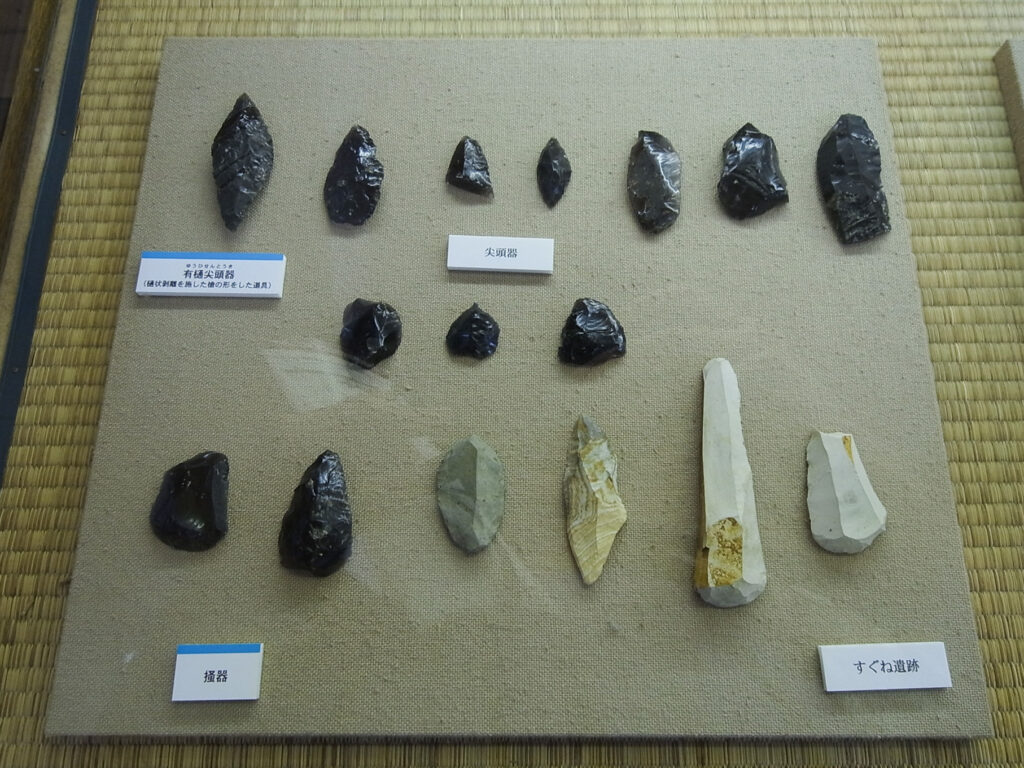
Next, we looked at the stone tools displayed along the wall. In the Jomon period, we can see more variations of stone tools, such as stone spatulas used for stripping animal skins, beautifully polished polished stone axes, shiny and sharp obsidian knives, and perforated jade. All of these items are familiar to visitors to archaeological museums, but the jade and obsidian stone tools reminded me of how close we are to the place of origin. Japan’s only jade production area is in the Himekawa River basin, which runs through the southwestern part of Niigata Prefecture, not far from here. And as mentioned above, the major obsidian production area is in the upper reaches of the Chikuma River (Shinano River). Tsunan, which is connected to the river, must have been an area where it was easy to obtain both types of stone.
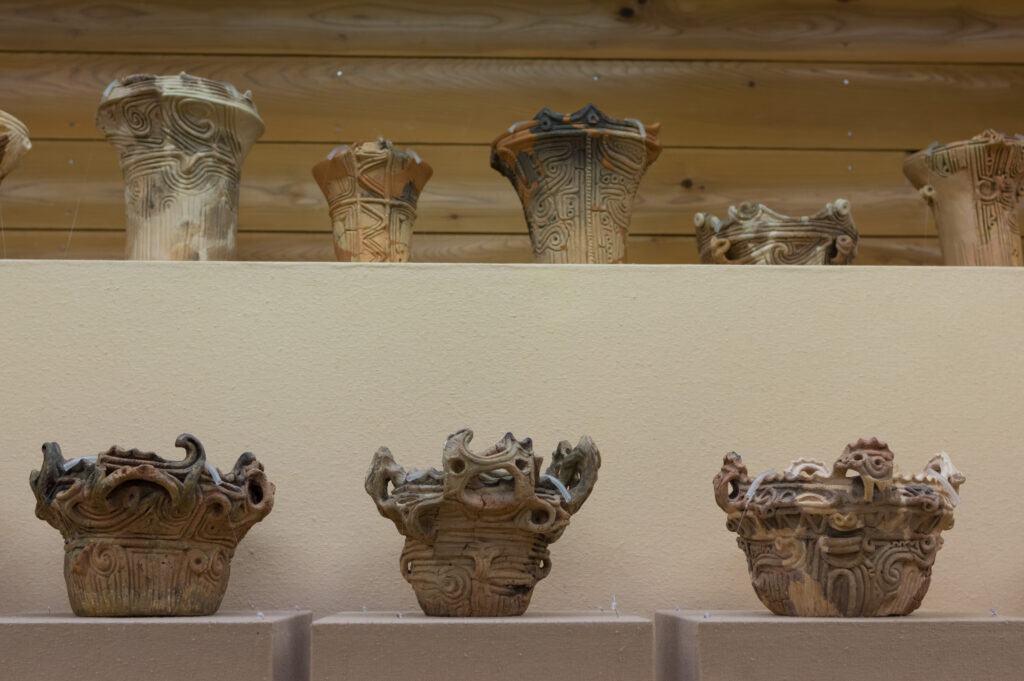
Earthenware from the Doujitte Site was displayed on a platform near the back wall. Most of them were deep bowls, about 20 to 30 cm high by eye measurement, but I noticed a vessel that looked like a small pot with the top and bottom of a Jomon Vessel with Flame-like Ornamentation squashed together. Even though it was small, it had the characteristic chicken head crown of the flaming earthenware, which made it very attractive.
At the Dojitte Site, not only flame-shaped earthenware but also earthenware with clearly different designs were found. The reason why I felt nostalgic when I saw them was because the atmosphere was similar to the earthenware I had seen in the past in the northern Kanto region, the Chubu highlands, and the foot of Mount Asama. However, I felt that it was somehow different from the local pottery. The distinctive shapes and patterns seem to have been recreated by the Jomon people of this region.
In particular, I was surprised to find that rare pottery called Yuko Tsubatsuki Doki, which is found in the central highlands, was also found in this area. It looks like a round barrel, is the kind of earthenware that evokes images of rituals, which is believed to be drumming and brewing tools.
In the Jomon period, information on pottery was probably carried directly by humans, but in addition to the often mentioned marriages and trade, there may have been cases where people gathered at festivals to imitate what they saw there.
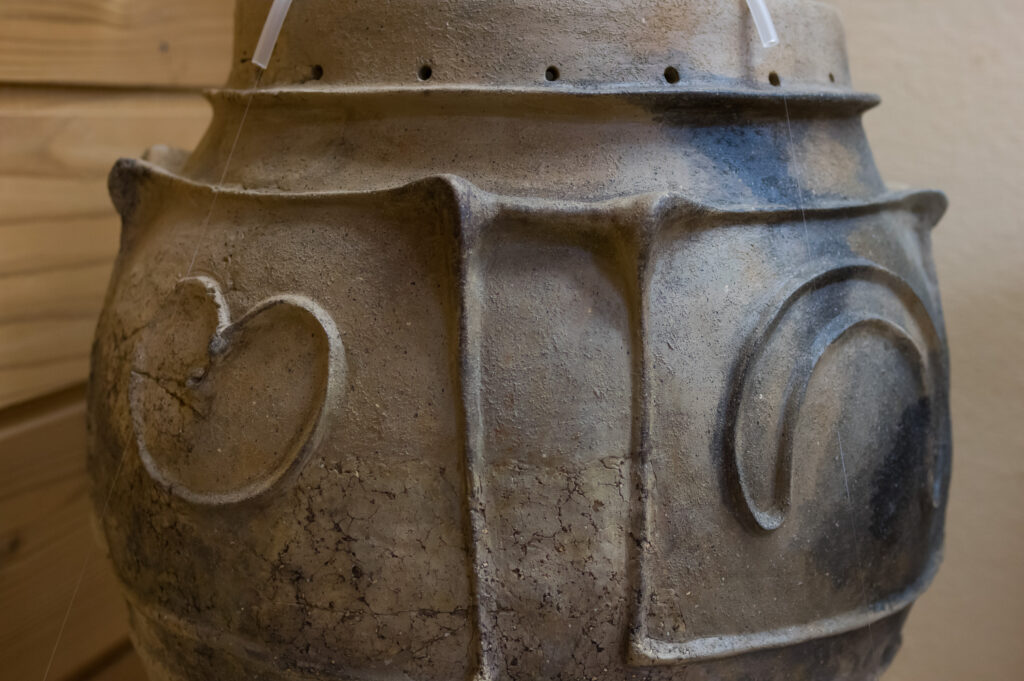
However, I had seen so many earthenware that I was starting to get sick of them. So I went downstairs to the second-floor archives, where I found a collection of folk artifacts from Akiyamago, a village known for Matagi in the upper reaches of the Nakatsu River. There were simple tools made from the surrounding nature, such as a basket made of woven rope and a beating stick made from a cut piece of wood used for processing grain, all lined up in a row, and it was as if I was looking at the traces of mountain life that had continued since the Jomon period. Needless to say, I felt as if I was in a never-ending dream.
When I went outside, the rain had stopped. I looked at my watch and saw that it was around 2:00 p.m., so I quickly looked for a place to eat and drink, and went into a ramen store that stood alone in the rice fields, and filled my stomach with spicy ramen noodles with lots of ingredients. I opened the map of the Naeba Geopark that I had received from Najomon and decided to visit the Okinohara Site, a national historic site not far from here.
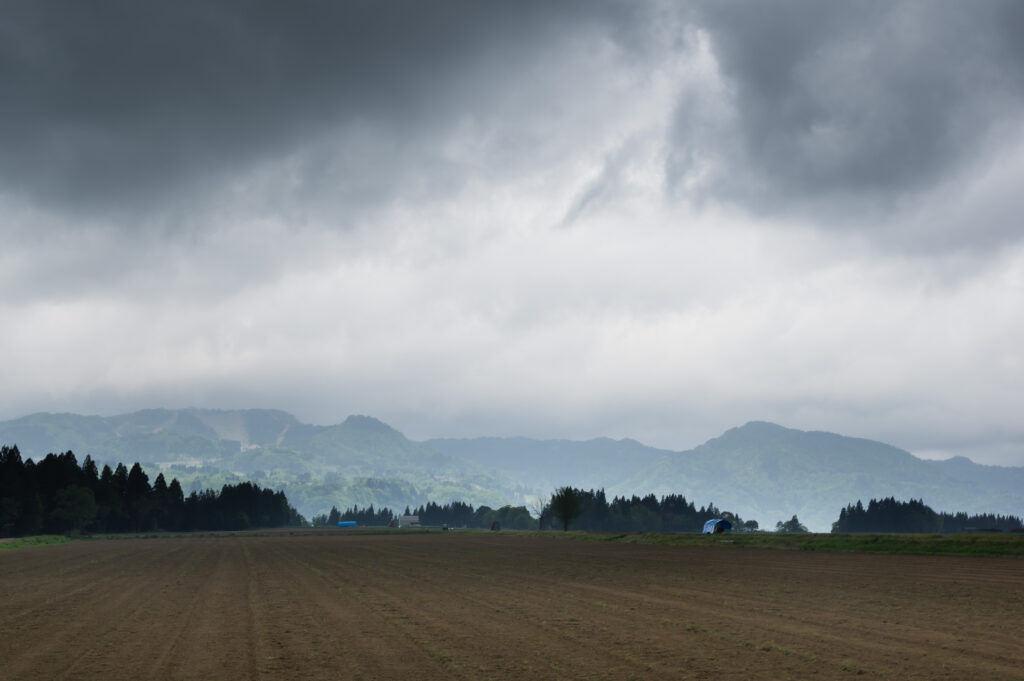
The Okinohara Site was located on a river terrace between the Shinano River and the Nakatsu River. Even though it is a river terrace, the difference in height from the river bed is about 160 meters. From below, it looked like a flat mountain, but as we drove up the slope, we were surprised to see a vast field of crops. The world below, where the river flows, is used as rice fields, and the plateau above, where there is no river, is used as fields. The freshly farmed fields looked very soft and fluffy.
As we drove slowly along a quiet farm road, we found a grassy area overgrown with weeds and a signpost that read “National Historic Site: Okinohara Site,” standing there indistinctly. There was no pit dwelling, nor was the area being maintained for tourists. However, this sense of abandonment was very close to the natural state, and it was convenient to imagine the Jomon period.
According to the information board on the roadside, the site has been found to be the remains of a circular village centering on a plaza, which was established between 5,300 and 4,000 years ago. What was found during the 3 excavation surveys were 49 pit dwelling ruins, three large dwelling ruins, one paving stone dwelling ruins, pottery including Jomon Vessel with Flame-like Ornamentation, stone tools, and cookie-like carbides. The remains are estimated to have lasted about 700 years. It is said that they have not been destroyed but are still lying at the foot of the mountain, and more excavations are planned in the future.
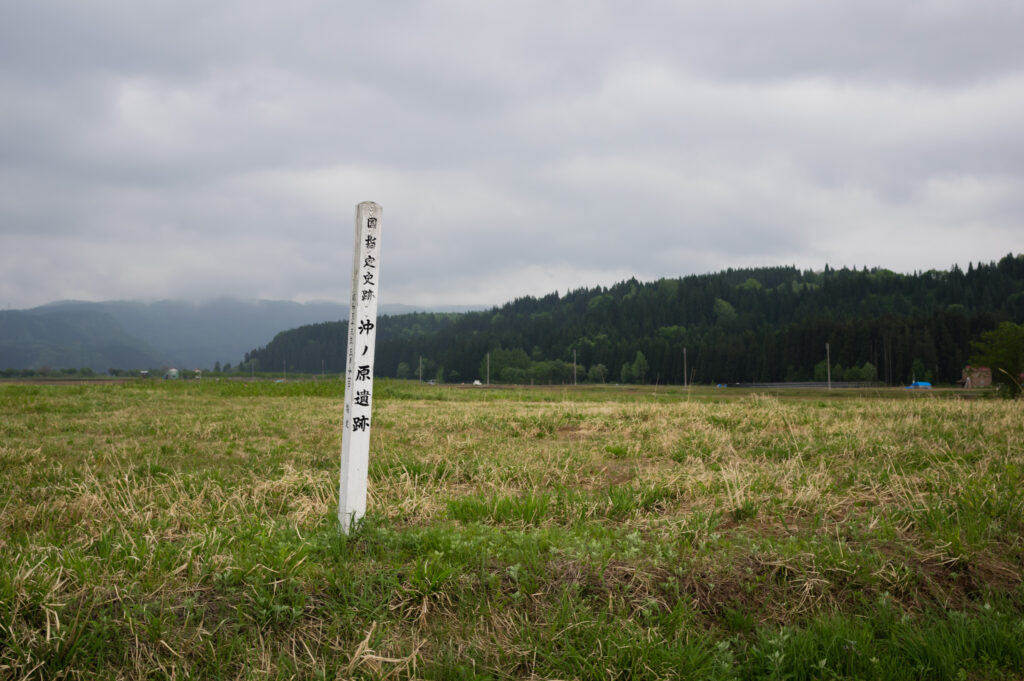
Perhaps it should be noted that the remains of a large pit house were found. The large pit dwelling, which looks like a horizontal extension of a pit dwelling, has been restored at the Sannai Maruyama Site in Aomori Prefecture, but there are many examples excavated in snowy areas such as the Hokuriku and Tohoku regions. These buildings have a variety of theories, such as a communal work hut for the winter or a meeting place for rituals and festivals.
In Tsunan, where winter occupies almost half of the year, as much as 3 meters of snow falls every year, and it is thought that the Tsushima Warm Current, which brings the heavy snowfall, started flowing into the Sea of Japan about 8,000 years ago. If it was snowing 5,500 years ago, then the theory of wintering in large pit houses becomes more plausible.
In order for the people of the Jomon village to get through the winter together, they first needed a place to gather, and the large pit houses with their warm fires seem to have played the role of a plaza. However, it may be possible to move to a more comfortable place to live for the winter… We will have to wait for the results of the planned excavation to find out the truth.
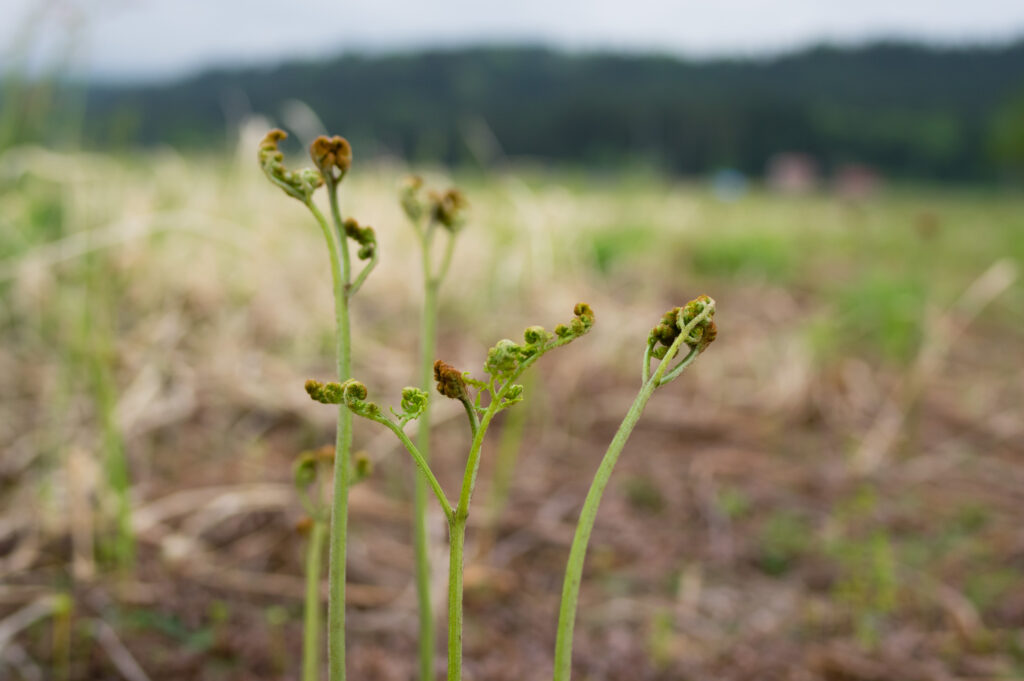
The clouds were hanging low and it looked like it was about to start raining. A cold wind blew from the mountains and shook the grass at my feet. Upon closer inspection, I realized that it was Warabi (bracken). When I looked around, I saw that it was growing everywhere. We had never gone for wild vegetables before, but it was a different story when the food was growing right in front of us. When we saw the bracken waving in the wind as if to say, “Go ahead, take it,” we got excited. And then I thought, “Wouldn’t the Jomon people’s hearts beat faster if they saw bracken like this?”
I believe that bracken was a valuable source of food for the Jomon people, who lived off the various blessings of nature. No, it was not just bracken. After the long winter, the first buds of butterbur sprout in spring, and the season of rich food such as royal fern, kogomi, udo, and taranome comes around. I think it will be a great joy to survive the harsh winter.
The snow that falls on the mountains melts away in the spring, creating a large amount of subterranean water that moistens the fields and mountains. If there is a spring near the village, animals will gather for the water, and it will be easy to hunt. If you can get over the winter, this is probably a good place to live with all the necessary conditions for hunting and gathering.
Water is indispensable for life. We felt that water was one of the reasons why the Jomon people, who lived in a region with heavy snowfall, continued to live here for 700 years, so we headed for Ryugakubo, which was selected as one of the 100 best waters in Japan, about 3 km from the Okinohara Site. And that thought turned into a conviction.
Ryugakubo was located in a forest down a cedar grove. Before I knew it, the vegetation had changed to a broad-leaved forest including beech trees, and the clear, unmixed water reflected the fresh green like a mirror, staining everything green. It was so beautiful that I wanted to shout with joy.
It is a reasonably large pond, with an area of about 1,2 hectares. I later found out that this is where the lava flow from Mt. Naeba stopped 300,000 years ago, and the water that seeped into the lava plateau gushed out here. The water gushes out at a rate of 18 to 30 tons per minute. Because the water in the pond is replaced every day, the water here is clear and never muddy.
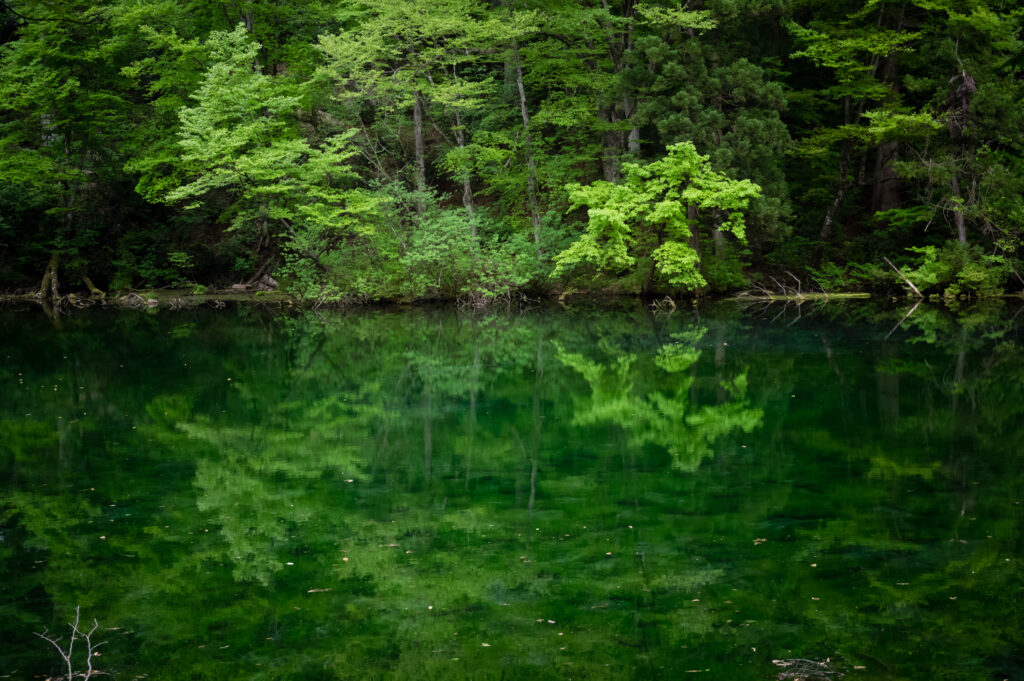
When I drank from the spring water outlet attached to the bottom of the small shrine by the pond, I found that the water was soft to the touch, refreshing and super soft. It was extremely delicious. I even thought for a moment that I could live here if I could drink this water.
It must be popular, because there were people coming to draw water. We filled our own bottles and walked to the Ryugakubo Shrine on the other side of the promenade around the pond. It was nice to hear the birds chirping.
As I walked, I thought about how valuable spring water must have been in the days when there was no tap water. Rivers can flood at any time, but spring water provides a stable supply of filtered water suitable for drinking. This place, with its constant supply of fresh and delicious water backed by a large amount of snowfall, is a lifeline for the people who have lived on the plateau without rivers. This is probably why this place has been protected as a sanctuary.
After paying our respects at the Ryugakubo Shrine, we dipped our hands in the pond, which was extremely cold. After confirming that water was gushing out from the edge of the lava plateau behind the shrine, we finally made our way home.
Tsunan, the hometown of the Jomon Vessel with Flame-like Ornamentation, was a place with delicious water flowing from the largest river in Japan. Since then, I have been secretly wondering if the shape of the Jomon Vessel with Flame-like Ornamentation is not “fire” but “water”.
Text : Tomoko Kusakari, Photo : Yoshiaki Hirokawa
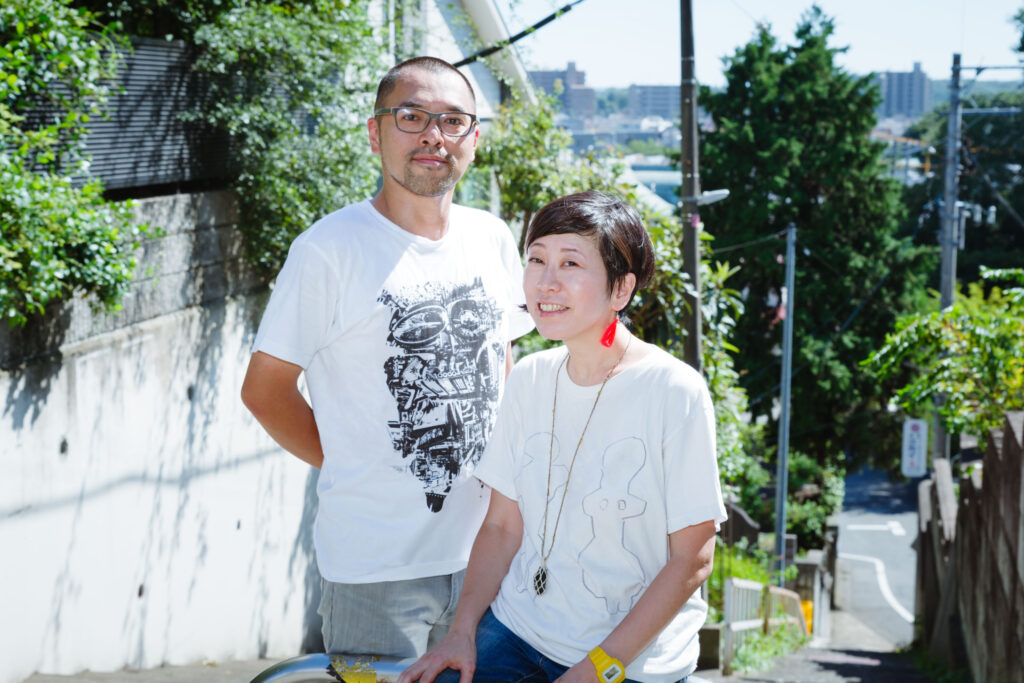
nawa to yajiri
(it means “Rope and Arrowhead”)
A unit for exploring the Jomon by Tomoko Kusakari (writing) and Yoshiaki Hirokawa (photography).
In addition to working as members of the NPO Jomonism, they also travel around Japan visiting Jomon ruins, archaeological sites and local museums, exploring the prehistoric values that can be deciphered from the forms and environments of the Jomon.
http://nawatoyajiri.com